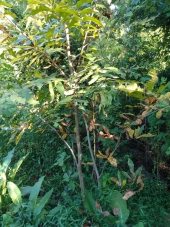Well.... You got plants, I got bamboo poles. We, Hunny and I braved the dangers of a local bamboo "patch". It measures roughly 100 feet deep and 500 feet long.

I know myself well enough to realize, I don't have the neccesary attentiveness to manage a patch in our zone. Besides, look what I can harvest from!!! Permission has been granted, ongoing. And it remains somebody else's problem!
A modular fence built over time, is my current thought. Something like below. It appears the youtuber did not mention treating his fence splits with anything.
 https://www.youtube.com/watch?v=NKzMbO-Hklw
https://www.youtube.com/watch?v=NKzMbO-Hklw
Edit: this load is for several trellises.











